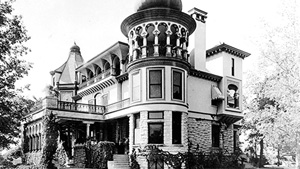From Proud Heritage, Vol. 1 by DCPA, not currently in print.
One of the prominent pioneers of Dallas County, James Horton, Sr., was a native of Virginia, and a son of Enoch and Martha Stinson Horton. In 1844 he came to Eagle Ford, Texas arriving in mid-November. He settled on a tract of 320 acres which has since been known as the James Horton headright. He at once began the work of improving it. From time to time he acquired other properties, and at the time of his death he was the owner of a 4,000 acre estate.
James Horton, Sr. journeyed to California on horseback in 1849 and was engaged in mining there for a time. He returned to Texas in 1851 at which time he married Miss Jane Phillips, a daughter of Nimrod Phillips; and they farmed in Eagle Ford. Wheat easily became the dominant crop, so much so that in the 1850’s Dallas County became known as the great wheat region of Texas. Most families in those years grew small amounts of cotton for domestic uses, but not until the 1870’s would cotton make North Texans begin to forget about wheat.
Until 1857 James Horton, Sr. followed farming exclusively. At that time he built the Eagle Ford Gris(t)mill, in which he was interested the rest of his life, as was his sister, Sarah Horton Cockrell. He got a “miller” by the name of Alexander Harwood and his son, Rifley B. Harwood, to operate it for him and Sarah. Sarah and her son, Frank, built the Dallas (grain) Elevator Co. about 1885.
James Sr. donated the land at Eagle Ford for the train depot; by September 1873, the Texas and Pacific Railroad had pushed as far as Eagle Ford, six miles west of Dallas, before it went temporarily bankrupt during the financial panic of that year, making that area near Oak Cliff a makeshift rail terminus and the most wide open town in the State of Texas. It abounded with railroad construction gangs, cattle drovers bringing their herds through town for shipment to market, gamblers, prostitutes and all manner of hustlers in general. Around 1878, Sam Bass and Arkansas Johnson held up the T&P near Eagle Ford, giving the local citizens some longed-for entertainment.
James Jr. gave the land for the Horton Cemetery for whites and Crestview Memorial Park, adjoining, for blacks. They are located east of Loop 12 (Walton Walker Blvd.) and south of Dallas/Ft. Worth Turnpike (1-30) in what is now Arcadia Park. They sold 200 acres of the homestead in September 1907 to the cement company still in operation in First known as Southwestern States Portland Cement Company, the name was changed to Trinity Portland Cement in 1915, and then in the early 1970’s it was changed again to the General Portland Cement Company.
James Jr. and his wife, Laura, became parents of seven children: Nuckie, Willis, Ridge “Reg” Mack, C. B., James III, Grant, and Lizzie. Mrs. Laura Carter Horton was a member of the Baptist Church. She and James Jr. are buried at Horton Cemetery.
“Reg” Mack Horton was born September 10, 1882 at Eagle Ford, and died October 16, 1942 and was buried at the Mesquite Texas Cemetery.
On January 13, 1913 “Reg” Mack Horton was married in Dallas to Eva Vida Montgomery, a daughter of John Rylie and Georgia Nance Montgomery. John Rylie Montgomery was the son of Thomas and Zeldra Rylie Montgomery. Eva Montgomery Horton was born December 1, 1895 at Kleberg, Texas. She died March 6, 1972 and is buried at Restland Memorial Park in Dallas.
Reg M. and Eva M. Horton had only one child, a daughter, Serena Mae Horton, born at Eagle Ford February 4, 1916. She married first Paul Barney Jones, who is deceased, and then Herbert Haskell Campbell. They live in Dallas.
Barney C. Jones, born September 7, 1936 in Dallas, married on September 19, 1957 to Claudia Marlene Wilcox, born December 9, 1927 in Crawfordsville, Indiana. They had one child, Melody Margaret Elizabeth Jones, born 1958 in Lebanon, Indiana.
By Barney C. Jones, Dallas


